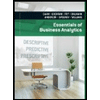
Connect 1 Semester Access Card for Fundamentals of Financial Accounting
5th Edition
ISBN: 9781259128547
Author: Fred Phillips Associate Professor, Robert Libby, Patricia Libby
Publisher: McGraw-Hill Education
expand_more
expand_more
format_list_bulleted
Concept explainers
Question
Chapter 13, Problem 16Q
To determine
Determine the difference of accounting policy that exists between Company T and Company E and the five ratios affected by this difference.
Expert Solution & Answer
Want to see the full answer?
Check out a sample textbook solution
Students have asked these similar questions
Can you explain the correct methodology to solve this financial accounting problem?
Can you explain the correct methodology to solve this financial accounting problem?
Can you help me solve this general accounting problem with the correct methodology?
Chapter 13 Solutions
Connect 1 Semester Access Card for Fundamentals of Financial Accounting
Ch. 13 - What is the general goal of trend analysis?Ch. 13 - Prob. 2QCh. 13 - What is ratio analysis? Why is it useful?Ch. 13 - What benchmarks are commonly used for interpreting...Ch. 13 - Prob. 5QCh. 13 - Prob. 6QCh. 13 - Slow Cellars current ratio increased from 1.2 to...Ch. 13 - From last year to this year, Colossal Companys...Ch. 13 - From last year to this year, Berry Bam reported...Ch. 13 - Explain whether the following situations, taken...
Ch. 13 - What are the two essential characteristics of...Ch. 13 - Prob. 12QCh. 13 - Prob. 13QCh. 13 - Prob. 14QCh. 13 - Prob. 15QCh. 13 - Prob. 16QCh. 13 - 1. Which of the following ratios is not used to...Ch. 13 - Prob. 2MCCh. 13 - Prob. 3MCCh. 13 - Analysts use ratios to a. Compare different...Ch. 13 - Which of the following ratios incorporates stock...Ch. 13 - Prob. 6MCCh. 13 - Prob. 7MCCh. 13 - A bank is least likely to use which of the...Ch. 13 - Prob. 9MCCh. 13 - (Supplement 13A) Which of the following items is...Ch. 13 - Calculations for Horizontal Analyses Using the...Ch. 13 - Calculations for Vertical Analyses Refer to M13-1....Ch. 13 - Interpreting Horizontal Analyses Refer to the...Ch. 13 - Interpreting Vertical Analyses Refer to the...Ch. 13 - Prob. 13.5MECh. 13 - Prob. 13.6MECh. 13 - Prob. 13.7MECh. 13 - Analyzing the Inventory Turnover Ratio A...Ch. 13 - Inferring Financial Information Using the Current...Ch. 13 - Prob. 13.10MECh. 13 - Identifying Relevant Ratios Identify the ratio...Ch. 13 - Prob. 13.12MECh. 13 - Analyzing the Impact of Accounting Alternatives...Ch. 13 - Describing the Effect of Accounting Decisions on...Ch. 13 - Prob. 13.1ECh. 13 - Prob. 13.2ECh. 13 - Prob. 13.3ECh. 13 - Computing Profitability Ratios Use the information...Ch. 13 - Prob. 13.5ECh. 13 - Matching Each Ratio with Its Computational Formula...Ch. 13 - Computing and Interpreting Selected Liquidity...Ch. 13 - Prob. 13.8ECh. 13 - Prob. 13.9ECh. 13 - Prob. 13.10ECh. 13 - Prob. 13.11ECh. 13 - Prob. 13.12ECh. 13 - Prob. 13.13ECh. 13 - Prob. 13.14ECh. 13 - Analyzing the Impact of Alternative Inventory...Ch. 13 - Prob. 13.1CPCh. 13 - Analyzing Comparative Financial Statements Using...Ch. 13 - Prob. 13.3CPCh. 13 - Prob. 13.4CPCh. 13 - Prob. 13.5CPCh. 13 - Prob. 13.6CPCh. 13 - Prob. 13.7CPCh. 13 - Prob. 13.1PACh. 13 - Analyzing Comparative Financial Statements Using...Ch. 13 - Prob. 13.3PACh. 13 - Prob. 13.4PACh. 13 - Interpreting Profitability, Liquidity, Solvency,...Ch. 13 - Using Ratios to Compare Loan Requests from Two...Ch. 13 - Prob. 13.7PACh. 13 - Prob. 13.1PBCh. 13 - Prob. 13.2PBCh. 13 - Prob. 13.3PBCh. 13 - Prob. 13.4PBCh. 13 - Interpreting Profitability, Liquidity, Solvency,...Ch. 13 - Using Ratios to Compare Loan Requests from Two...Ch. 13 - Prob. 13.7PBCh. 13 - Prob. 13.1SDCCh. 13 - Prob. 13.2SDCCh. 13 - Prob. 13.5SDCCh. 13 - Prob. 13.6SDCCh. 13 - Prob. 13.7SDCCh. 13 - Prob. 13.1CC
Knowledge Booster
Learn more about
Need a deep-dive on the concept behind this application? Look no further. Learn more about this topic, accounting and related others by exploring similar questions and additional content below.Similar questions
- Please provide the solution to this general accounting question using proper accounting principles.arrow_forwardPlease provide the correct answer to this general accounting problem using accurate calculations.arrow_forwardI need help with this financial accounting question using standard accounting techniques.arrow_forward
- I need help with this general accounting question using standard accounting techniques.arrow_forwardI am trying to find the accurate solution to this financial accounting problem with the correct explanation.arrow_forwardPlease help me solve this financial accounting question using the right financial principles.arrow_forward
- I am searching for the correct answer to this financial accounting problem with proper accounting rules.arrow_forwardI need help finding the accurate solution to this financial accounting problem with valid methods.arrow_forwardI am looking for help with this general accounting question using proper accounting standards.arrow_forward
arrow_back_ios
SEE MORE QUESTIONS
arrow_forward_ios
Recommended textbooks for you
 Intermediate Financial Management (MindTap Course...FinanceISBN:9781337395083Author:Eugene F. Brigham, Phillip R. DavesPublisher:Cengage Learning
Intermediate Financial Management (MindTap Course...FinanceISBN:9781337395083Author:Eugene F. Brigham, Phillip R. DavesPublisher:Cengage Learning
 Fundamentals of Financial Management, Concise Edi...FinanceISBN:9781285065137Author:Eugene F. Brigham, Joel F. HoustonPublisher:Cengage Learning
Fundamentals of Financial Management, Concise Edi...FinanceISBN:9781285065137Author:Eugene F. Brigham, Joel F. HoustonPublisher:Cengage Learning Auditing: A Risk Based-Approach (MindTap Course L...AccountingISBN:9781337619455Author:Karla M Johnstone, Audrey A. Gramling, Larry E. RittenbergPublisher:Cengage Learning
Auditing: A Risk Based-Approach (MindTap Course L...AccountingISBN:9781337619455Author:Karla M Johnstone, Audrey A. Gramling, Larry E. RittenbergPublisher:Cengage Learning Essentials Of Business AnalyticsStatisticsISBN:9781285187273Author:Camm, Jeff.Publisher:Cengage Learning,
Essentials Of Business AnalyticsStatisticsISBN:9781285187273Author:Camm, Jeff.Publisher:Cengage Learning,

Intermediate Financial Management (MindTap Course...
Finance
ISBN:9781337395083
Author:Eugene F. Brigham, Phillip R. Daves
Publisher:Cengage Learning


Fundamentals of Financial Management, Concise Edi...
Finance
ISBN:9781285065137
Author:Eugene F. Brigham, Joel F. Houston
Publisher:Cengage Learning


Auditing: A Risk Based-Approach (MindTap Course L...
Accounting
ISBN:9781337619455
Author:Karla M Johnstone, Audrey A. Gramling, Larry E. Rittenberg
Publisher:Cengage Learning

Essentials Of Business Analytics
Statistics
ISBN:9781285187273
Author:Camm, Jeff.
Publisher:Cengage Learning,
Chapter 6 Merchandise Inventory; Author: Vicki Stewart;https://www.youtube.com/watch?v=DnrcQLD2yKU;License: Standard YouTube License, CC-BY
Accounting for Merchandising Operations Recording Purchases of Merchandise; Author: Socrat Ghadban;https://www.youtube.com/watch?v=iQp5UoYpG20;License: Standard Youtube License